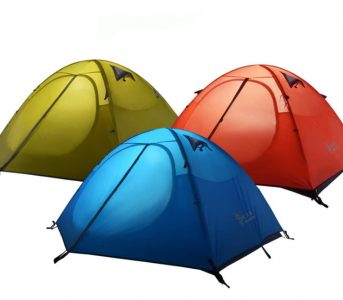Introduction
Quick Navigation
One of the most stimulating activities that you can engage in is outdoor activities. Outdoor activities are usually exciting, and they help to clear your mind. However, you will not enjoy the outdoors if you are not well-prepared for your journey. If you plan to go hunting or camping, you must provide a suitable place for you to rest and spend the night. The easiest and most common way is to carry a tent. However, before you can get a tent for a particular outdoor trip, you must consider the current climate season. The same tent that will serve you during a winter blizzard will be inappropriate for a summer boot camp. Manufacturers of outdoor tents are well-aware of this fact, and that is why they produced tents well suited to multiple kinds of weather. These tents are called 3-season and 4-season tents. If you are looking for information on these two tent categories, then you are in luck. In this article, we are going to explain the tents and show you the differences between them. Enjoy!
3-Season Tents
3-season tents are tents that are uniquely built for cool, stable, and temperate weather conditions. These weather conditions usually fall between spring, summer, and fall; hence the name 3-season tents. These tents are designed with some unique features, and we are going to explain them in detail.
- Designed for three climate seasons
This tent is majorly designed to be used during three climate seasons. These seasons include spring, summer, and fall. During this period, the weather is not harsh, and the 3-season tent will do a good job of keeping you safe. Although this tent is designed for cool and temperate weather conditions, it also provides shelter from the rain, wind, and light snowfall. However, using it in a harsh weather environment might not be a good idea. The tent protects you from bugs, a direct wind, and any other external harm.
- Lightweight and versatile structure
3-season tents are uniquely designed with a lightweight structure. The materials used in making the tents, the poles, and the setup are all tailored towards reducing weight and bulkiness. The poles are usually trekking poles, and they can weigh as low as 3 lbs. This means that you can easily transport them while putting your tent in a handy bag. The materials used in producing 3-season tents are usually very light. The floor and the body of the tent are designed to be less bulky. 3-season tents also utilize thinner aluminum frames and sleeveless poles setup. Although it might seem like the tent cannot adequately protect you, that is far from the fact. The frames are still strong enough to withstand all mild weather events.
- Designed to provide ventilation
One of the better features of 3-season tents is that it is designed to allow for maximum ventilation. The tents are usually designed with lots of vents and open meshy walls that allow you to stay cool in a summer camp. The tent is built to avoid the negative effects of direct wind while allowing air to pass through the tent fully. The side rain cover is also designed to sit off the ground, allowing for more air in the tent.
4-Season Tents
4-season tents are uniquely built to keep you safe during heavy snows, harsh winds, or heavy downpours. It is called a 4-season tent because it can be used all season (including winter. Check out the features of 4-season tents.
- Designed for four climate seasons
The 4-season tent is usually referred to as a tent that is designed to take it all. This tent is designed to protect you from snow buildup, snow, ice, hail, and harsh winds. If you are going outdoors during winter, then carrying a 4-season tent will be the best option.
- Strong and heavy structure
The structure of this tent is very strong because it is designed for extreme conditions. The tent is made with polyester, which helps trap heat in the tent while blocking outraging winds. These tents are also designed with vestibules extended to the ground to prevent wind from getting in the tent. The flaps also fold inward, and this allows for sturdiness and stability. The aluminum used in constructing these tents are also quite thick, and full fabric sleeves are used for protection.
- Designed to reduce ventilation
4-season tents don’t usually allow for ventilation. Although they are designed with ventilation vents, these vents are usually targeted at controlling the amount of breathable air in the tent.
Differences between 3 season tents and 4 season tents
- Appropriate Time for Usage
Most people buy 3-season tents because it can be used in almost any situation apart from harsh weather. Some people even use it during winter, but this is ill-advised. While 3 season tents are usually used all the time, 4 season tents are reserved when the weather is harsh.
- Structure
3-season tents have a significantly lighter structure than 4-season tents. 4 -season tents are designed to be heavy so that they can stay rooted during harsh storms.
- Setup
3-season tents are easier to transport and set up than 4-season tents. 3-season tents are made with lighter materials, and they can be detached and carried easily. 4-season tents utilize a greater number of materials
- Comfortability
Both of these tents are made to keep you comfortable. However, how they keep you comfortable is where the difference lies. 4-season tents usually have warmer interiors, while 3-season tents have cooler interiors. This is mostly because 4-season tents are used in colder climates while 3-season tents are used in warmer climates.
Conclusion
If you love outdoor activities, then you will enjoy them better with the right equipment. Tents are designed to give you a place to sleep and rest when you are outdoors, and you should be particular about which one you choose to carry along with you. We have shown you the differences between 3-season tents and 4-season tents. You should choose the one relevant to your environment and your needs. Cheers!

